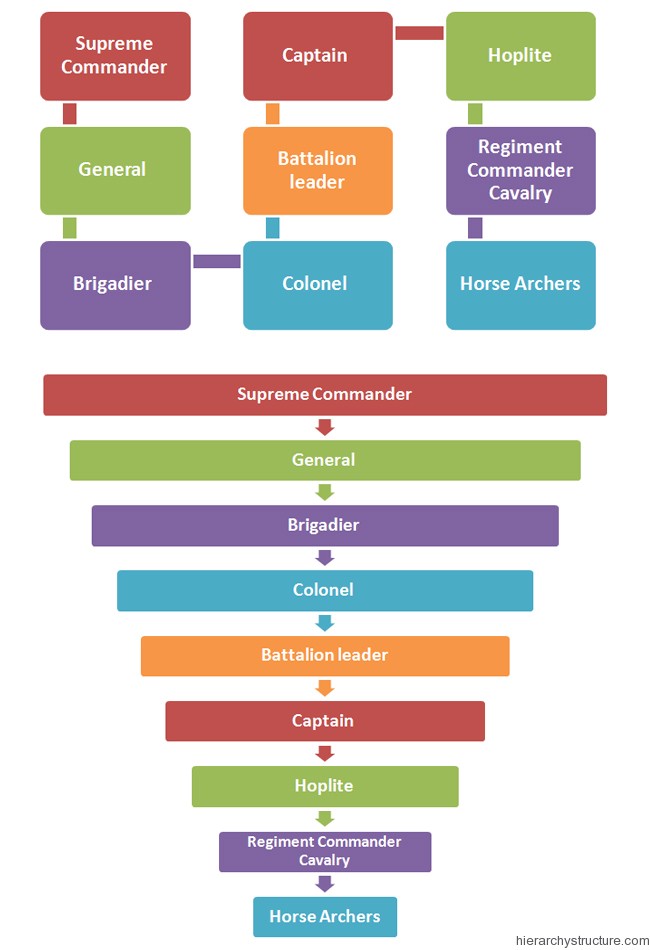The ancient Greek military hierarchy ran parallel to the social structure or social hierarchy in ancient Greece. Like in the social structure of ancient Greece, aristocratic class got the higher positions in the military hierarchy also. People from aristocratic classes were placed on higher military ranks and people from lower classes served military from the lower ranks and were not eligible for promotions on certain higher ranks.
Although the ancient Greek military hierarchy got imbued with the similar social structure but the military was considered as lot more than just an obligatory service. The patriotic traits among the people of all social classes acted as a unifying force result of which could be seen as great coordination on the battlefield. Following are the major ranks that constituted ancient Greek military hierarchy:

- Supreme Commander (Polemarchos)
- General (Starategos or Stratigos)
- Brigadier (Taxiarhos)
- Colonel (Syntagmatarkhis)
- Battalion leader (Tagmatarkhis)
- Captain (Lokhagos)
- Hoplite (Foot Soldier)
- Regiment Commander Cavalry (Hyparchos or Hipparmostes)
- Horse Archers (Hippotoxotes)
Supreme Commander (Polemarchos)
Polemarch was the rank that was assigned to the senior most Military Position official which meant warlord or war leader. The major responsibility of a Polemarchos was to give direction and command to the army officers. He was responsible for strategizing and monitoring army operations.
General (Starategos or Stratigos)
This rank was assigned to the general or army leader. These officials were responsible for organizing, maintaining and commanding the military operations on the war field or off the field. These officials were also responsible for attending the court trials and acting as magistrates for the same.
Brigadier (Taxiarhos)
This rank was assigned to the brigadier of the military. These were the officials who were responsible for strategizing and commanding the operations in a phylai.
Colonel (Syntagmatarkhis)
This rank was assigned to the leader of the regiment which at Greek time was known as Syntagma. These officers were responsible for commanding the operations of a regiment.
Battalion leader (Tagmatarkhis)
A Tagmatarkhis was the commander of a Tagma (battalion). These were responsible for handling their battalions during military operations.
Captain (Lokhagos)
A Lokhagos was the name given to the official who was appointed as the leader of a lochos. These officers acted as the captains in the military and their insignia represented three silver stars.
Hoplite (Foot Soldier)
A hoplite was the name given to the soldiers who were appointed in the ancient Greek’s city states. These officers were armed as spearmen and they were required to fight in a phalanx formation. They were known as hoplites because of the shield that they used to protect them. This shield was known as hoopla.
Then there are two other ranks which primarily do not come under the hierarchy but these ranks ran parallel to the main military hierarchy.
Regiment Commander Cavalry (Hyparchos or Hipparmostes)
These officials were the powerful warriors with mounted armours. They acted as soldiers. A regiment of cavalry was the regiment of mounted archers.
Horse Archers (Hippotoxotes)
As per ancient Greek military hierarchy some soldiers were not considered to be direct part of military. These were one of those soldiers which were referred in the non-military context and are even today symbolized as the horse archers or the soldiers with arch riding on the horse.
